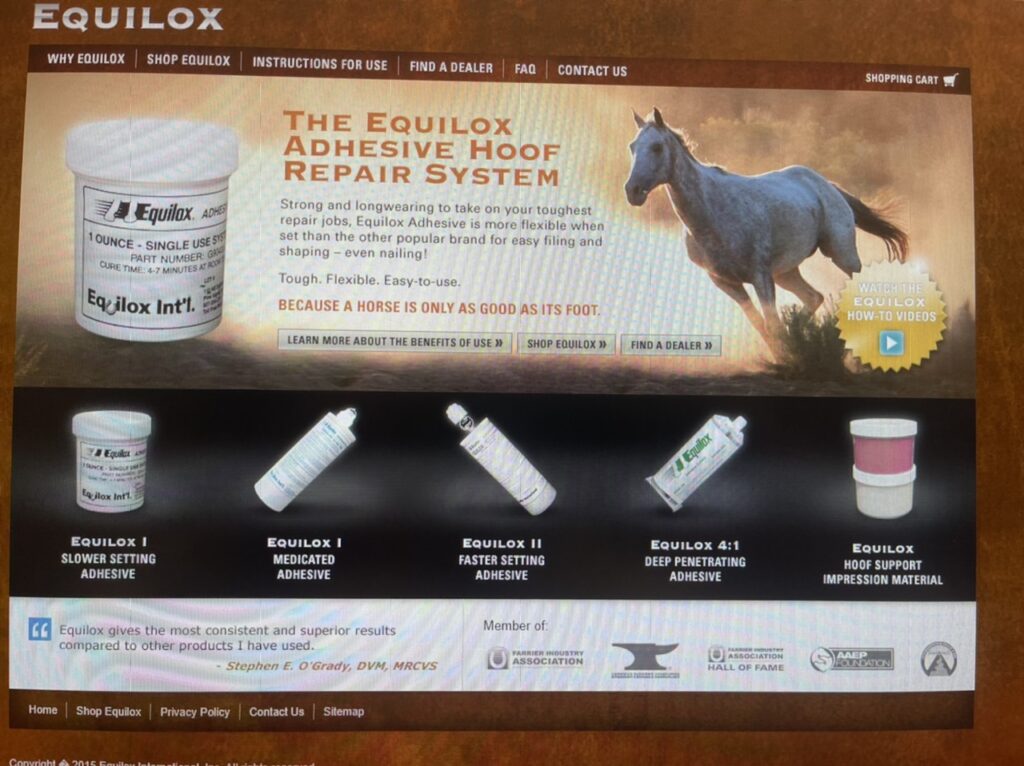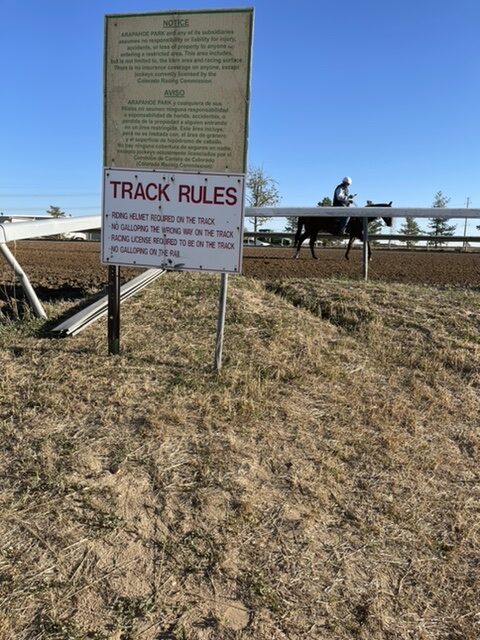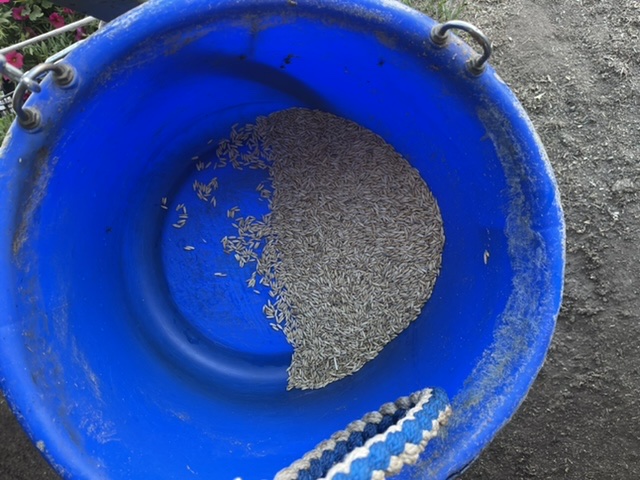Racehorses Get A Lot of Exercise
They get turned out walking on a hot walker for 20-45 minutes once or twice a day. They get galloped, breezed or worked (each is progressively faster and the work is a timed workout reported to the track which must be completed twice in 60 days if the horse hasn’t been raced in 6 months, and every 6 months thereafter for horses actively racing).
And they share a lot of useful remedies with other disciplines to keep horses sound, but they have some of their own.
Their Bits are All Snaffles

Racehorses Eat A Lot
Fiber is an energy source that is often overlooked in horse nutrition. Horses have a highly developed hindgut that houses billions of bacteria and protozoa capable of fermenting large quantities of fiber. The end products of fiber fermentation can be used as energy sources throughout the day because fermentation continues long after a meal has been eaten. Racehorses are generally fed unlimited hay, which amounts to a staggering 15-20 lb (a whole small bale) per day of clean grass hay such as timothy or oaten hay. Smaller quantities of alfalfa hay (2-4 lb or 0.9 to 1.8 kg per day) may also be offered. This level of hay intake will meet the racehorse’s maintenance DE requirement and help protect against gastric ulcers and colic.
Feeding hay alone would leave the racehorse with an energy deficit of around 15-20 Mcal DE, and this must be supplied from other energy sources. Traditionally, these extra calories needed to fuel the racehorse were supplied by straight cereal grains such as oats, corn, and barley. The main fuel source in cereal grains is starch. Starch is the dietary energy source of choice for glycogen synthesis because starch digestion results in a direct rise in blood glucose and insulin, two of the most important factors involved in glycogen synthesis.
There is a limit, however, to the amount of starch that a racehorse’s ration should contain. When large grain meals are fed to horses, a portion of the starch may escape digestion in the small intestine and rapidly ferment in the cecum and colon. Changes in the pH of the hindgut due to alterations in the microbial populations and acid profiles may result in hindgut acidosis. Horses with hindgut acidosis may develop anorexia, colic, or display stereotypical behaviors such as wood-chewing and weaving. Kentucky Equine Research (KER) has developed a hindgut buffer called EquiShure® that is designed to buffer excess acids produced in the hindgut. In a controlled study, Thoroughbreds fed timothy hay and an all-grain sweet feed had significantly lower lactic acid concentrations in their feces when supplemented with EquiShure compared to unsupplemented horses.
In addition to feeding hindgut buffers, hindgut acidosis can be controlled by limiting meal size and by substituting alternative energy sources for a portion of the starch in a racehorse feed. As a rule of thumb, never feed more than 5 lb (2.2 kg) of grain in a single meal to a racehorse.
Racehorses that experience exertional rhabdomyolysis (RER) or tying-up should be fed a very low-starch diet. Research conducted at the University of Minnesota in conjunction with KER demonstrated that replacing the grain in the diet of Thoroughbred horses with a history of tying-up with a low-starch, high-fat feed will significantly decrease the amount of muscle damage they experience.
In a feeding trial, Thoroughbred horses with RER were exercised on a treadmill for five days a week while they consumed hay and a variety of energy supplements. When the daily caloric intake of a high-starch ration was kept low, the horses had lower post-exercise serum CK (a measure of muscle damage) than when this feed was increased to a level commonly fed to racehorses. In contrast, if extra calories were provided from a low-starch, high-fat feed (Re-Leve®), no increase in post-exercise serum CK activity occurred. Since these studies were conducted, Re-Leve has been used to successfully manage RER in hundreds of Thoroughbred racehorses around the world.
Fat
Fat is an attractive alternative energy source for racehorse rations, supplying a large number of calories in a concentrated form. Even though horses do not consume large quantities of fat in the wild, they are able to digest fats efficiently, particularly vegetable oils. Most vegetable oils contain long-chain (16-18 carbon) unsaturated fats. These fats are liquid at room temperature and are used extensively as human foods for cooking and salad oils. Once adapted, horses will digest over 90% of the vegetable oil in a ration, even when fed at levels as high as 2 to 2.5 cups (500-600 ml) per day. High levels of oil intake should be reached slowly, however, since some horses may develop loose, greasy feces when switched to a high-oil diet too quickly.
The energy density of vegetable oils is quite high, averaging about 2.25 times that of starch. Vegetable oil has about 2.5 times as much digestible energy (DE) as maize and 3.0 times as much DE as oats. Because of its high digestibility, fat is a very safe energy source. Even if some oil escapes digestion in the small intestine, it will not cause major disruptions of fermentation in the hindgut since bacteria cannot ferment long-chain oils.
Highly Fermentable Fiber
An interesting alternative energy source for performance horses is beet pulp, a byproduct of the sugar beet industry, made by drying the residual pulp after the sugar has been extracted. It contains a high percent of fermentable fiber, and its DE content is similar to oats.
Protein
If the protein content of a racehorse’s ration exceeds its requirement, then the extra protein can be used as a source of energy. The amino acids from this extra protein are broken down by the liver, and the nitrogen from the protein is excreted as ammonia. The carbon “skeletons” that are left can be oxidized to produce ATP or used to make glucose or fat.
Excessive protein intake should be avoided in the exercised horse for a number of reasons: (1) water requirements increase with increased protein intake; (2) urea levels increase in the blood leading to greater urea excretion into the gut, which may increase the risk of intestinal disturbances such as enterotoxemia; and (3) blood ammonia increases cause a number of problems such as nerve irritability and disturbances in carbohydrate metabolism.
Increased ammonia excretion in the urine may also lead to respiratory problems because of ammonia buildup in the stall.
Racehorse Feeds
Over the past decade, there has been a shift away from feeding straight cereal grains towards the use of commercial products formulated specifically for racehorses. These manufactured feeds use alternative energy sources such as fat and fermentable fiber to reduce the proportion of energy supplied by starch. They are also fortified to meet all of the racehorse’s nutrient requirements, including energy, vitamins and minerals when fed with an appropriate amount of forage.
A sweet feed consisting of only grain and molasses would derive 60-65% of its calories from starch and sugar. A well-formulated racing feed would limit the caloric contribution of starch and sugar to less than 50%, deriving 20-30% of its calories from fat. These feeds will usually contain between 6-10% fat along with highly fermentable fiber sources such as beet pulp. They are typically fed at levels of intake equal to 10-15 lb per day.
Racehorses Get a Lot of Care
Before work they get polo wraps on the front legs. After, a good hosing down.
When a horse breezes, or works at a moderate speed, he will usually have all four legs wrapped with trace bandages, which are similar to a human Ace bandage.
“These wraps are not as bulky as polo wraps,” Murty said. Polos are made of a thicker cotton material. “No one will breeze in a polo or when it’s wet out because the wraps can get heavy.”
Once wraps are heavy, they might slip down and come loose, creating a safety hazard for horse and jockey.
Polo wraps are used if a horse is jogging or galloping. They are typically worn on horses in training. They can also be worn if the horse is tack walking to prevent scrapes or other injury.
Racehorses wear almost exclusively back bandages. Horses are more likely to “run down” or accumulate scrapes on the ankles from track contact in back than in front, so precautions are taken to make sure no abrasions occur. Horses running in wraps up front can also raise suspicion if they are in a claiming race, Murty said. Prospective owners may be concerned the wrap is supporting a tendon that may be damaged, potentially influencing his future racing career.
This, however, is an unfounded idea. Wrapping a horse’s legs will not prevent a bow if the horse already has a partial tear, according to Dr. Rhonda Rathgeber of Hagyard Equine Medical Institute. Rathgeber also notes that some horses are more sensitive to having bandages on, which could prevent them from running their best race.
The most critical aspect when bandaging a horse is to have a skilled person applying the bandage.
“Pressure has to be distributed around the fetlock and up the tendon properly to ensure even pressure,” Murty said.
Uneven pressure from improperly applied bandages can increase the chance of a bandage coming off or down, potentially causing an accident or harm to other horses and riders working at the same time.
The leg also needs to be completely clean and dry before the bandage is applied.
“Sometimes if the leg is not clean and dry, you can get swelling or infection even though the bandage is applied properly,” said Rathgeber.
Rathgeber notes a few reasons why a horse should not be bandaged. These include:
– an injury that has not yet been treated properly
– topical or caustic ointments or medications on the leg
– the wraps don’t fit well
Wrapping an old injury isn’t always necessary; if a horse has a bowed tendon that has been allowed to heal completely, many trainers will not wrap as the horse doesn’t need the support a bandage provides.
“There is no scientific evidence that removing that support will cause an injury,” Rathgeber said.
The vets are around most days for horses that need it. Others get their legs iced, poulticed, or coated in this white paste, which is clay often mixed with DMSO to draw out heat. Smarty has not needed any of that in the past and has always been sound, but it’s like spa day for horses everyday at the track in the better barns.
Excerpts from:
https://ker.com/equinews/think-energy-when-feeding-the-racehorse/
_____________________________________________
Magna Poultice is a decongestant paste that can be applied to horses and cattle to treat strains, sprains, bruises, swellings, acute mastitis, and swollen glands. It’s an osmotic agent that can be applied externally and is said to quickly reduce inflammation and swelling. Magna Poultice contains 60% Epsom salt in a water-soluble base and can be reapplied within 24 hours if needed.
_____________________________________________

















